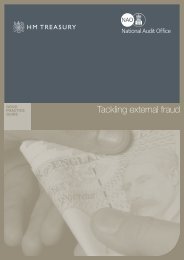4. First case study – the subdivision of the light - HM Treasury
4. First case study – the subdivision of the light - HM Treasury
4. First case study – the subdivision of the light - HM Treasury
Create successful ePaper yourself
Turn your PDF publications into a flip-book with our unique Google optimized e-Paper software.
F05 Ch4 Subdivision <strong>of</strong> <strong>the</strong> <strong>light</strong>.doc<br />
05/04/2006 19:34:00<br />
Technological roulette <strong>–</strong> a multi-disciplinary <strong>study</strong> <strong>of</strong> <strong>the</strong> dynamics <strong>of</strong> innovation in electrical, electronic<br />
and communications engineering.<br />
<strong>4.</strong> <strong>First</strong> <strong>case</strong> <strong>study</strong> <strong>–</strong> <strong>the</strong> <strong>subdivision</strong> <strong>of</strong> <strong>the</strong> <strong>light</strong><br />
The technique was essentially a scientific curiosity until viable batteries became<br />
available with <strong>the</strong> work <strong>of</strong> Daniell, Grove and Bunsen. Jobard, in 1838, and Grove, in<br />
1840, gave demonstrations <strong>of</strong> incandescence, but did not produce a practical <strong>light</strong>ing<br />
system.<br />
An English patent was granted to Frederick De Moleyns in 1841 for a lamp which<br />
consisted <strong>of</strong> an exhausted spherical glass globe containing two coils <strong>of</strong> platinum wire<br />
contacted by powdered charcoal.<br />
Jehl 1937<br />
Fig. <strong>4.</strong>25 De Moleyn’s lamp<br />
(1841)<br />
J.W. Starr, a young American from<br />
Cincinnati, gained an English patent<br />
EN Pat 10919/1845 which disclosed two forms <strong>of</strong><br />
incandescent lamp. One embodiment<br />
comprised a carbon rod in a Torricellian<br />
vacuum whilst <strong>the</strong> o<strong>the</strong>r had a burner<br />
formed from a strip <strong>of</strong> leaf-platinum.<br />
Reports <strong>of</strong> this lamp provided Swan with<br />
his initial stimulus to investigate <strong>the</strong><br />
possibilities <strong>of</strong> electric <strong>light</strong>ing.<br />
Staite and Petrie, who were pioneers<br />
<strong>of</strong> <strong>the</strong> arc, constructed glow lamps in <strong>the</strong> period 1848-9 using platinum<br />
and iridium as <strong>the</strong> burner materials. Swan encountered <strong>the</strong>se<br />
Jehl 1937<br />
Fig. <strong>4.</strong>27 Lodyguine’s<br />
graphite burner lamp<br />
manifestations at a demonstration <strong>of</strong> a<br />
platino-iridium alloy-based lamp given by Staite at <strong>the</strong><br />
Sunderland A<strong>the</strong>naeum and by Richardson during<br />
subsequent lectures at <strong>the</strong> same place.<br />
During <strong>the</strong> 1850s and 1860s, various workers<br />
performed sporadic experiments on <strong>the</strong> incandescent lamp<br />
using mainly platinum, iridium or carbon as <strong>the</strong>ir burner.<br />
No viable lamp was produced, firstly because <strong>the</strong>y all<br />
suffered <strong>the</strong> problem encountered during <strong>the</strong> development<br />
<strong>of</strong> <strong>the</strong> arc lamp, that no economic source <strong>of</strong> electricity was<br />
available, and, secondly, it was not possible to create a high<br />
85<br />
Fürst 1926<br />
Fig. <strong>4.</strong>26<br />
Starr’s carbon<br />
rod lamp<br />
(1845)





![AIRTO [Professor Dr Brian Blunden] - HM Treasury](https://img.yumpu.com/15492848/1/184x260/airto-professor-dr-brian-blunden-hm-treasury.jpg?quality=85)










